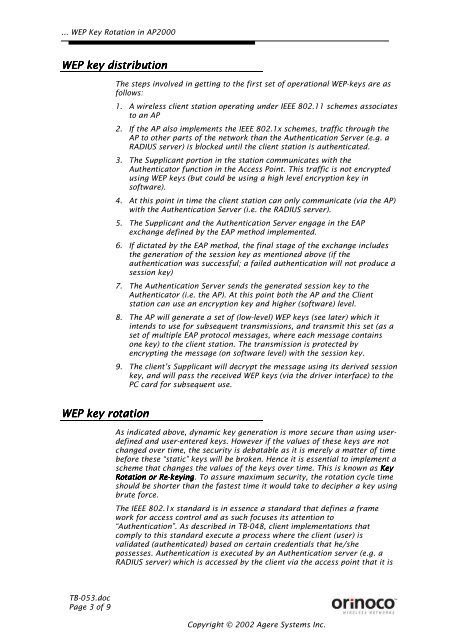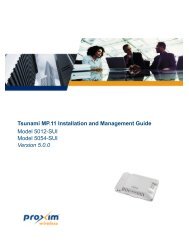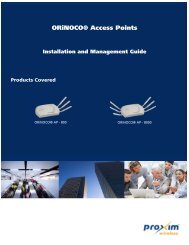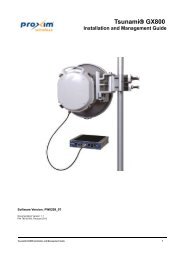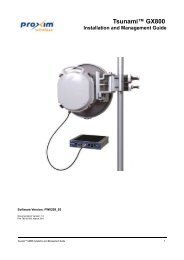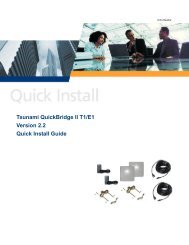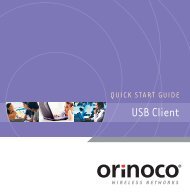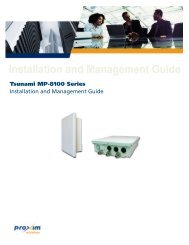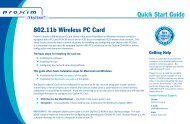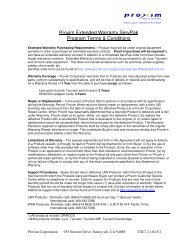... WEP Key Rotation in AP2000
... WEP Key Rotation in AP2000
... WEP Key Rotation in AP2000
Create successful ePaper yourself
Turn your PDF publications into a flip-book with our unique Google optimized e-Paper software.
... <strong>WEP</strong> <strong>Key</strong> <strong>Rotation</strong> <strong>in</strong> <strong>AP2000</strong><strong>WEP</strong> key distributionThe steps <strong>in</strong>volved <strong>in</strong> gett<strong>in</strong>g to the first set of operational <strong>WEP</strong>-keys are asfollows:1. A wireless client station operat<strong>in</strong>g under IEEE 802.11 schemes associatesto an AP2. If the AP also implements the IEEE 802.1x schemes, traffic through theAP to other parts of the network than the Authentication Server (e.g. aRADIUS server) is blocked until the client station is authenticated.3. The Supplicant portion <strong>in</strong> the station communicates with theAuthenticator function <strong>in</strong> the Access Po<strong>in</strong>t. This traffic is not encryptedus<strong>in</strong>g <strong>WEP</strong> keys (but could be us<strong>in</strong>g a high level encryption key <strong>in</strong>software).4. At this po<strong>in</strong>t <strong>in</strong> time the client station can only communicate (via the AP)with the Authentication Server (i.e. the RADIUS server).5. The Supplicant and the Authentication Server engage <strong>in</strong> the EAPexchange def<strong>in</strong>ed by the EAP method implemented.6. If dictated by the EAP method, the f<strong>in</strong>al stage of the exchange <strong>in</strong>cludesthe generation of the session key as mentioned above (if theauthentication was successful; a failed authentication will not produce asession key)7. The Authentication Server sends the generated session key to theAuthenticator (i.e. the AP). At this po<strong>in</strong>t both the AP and the Clientstation can use an encryption key and higher (software) level.8. The AP will generate a set of (low-level) <strong>WEP</strong> keys (see later) which it<strong>in</strong>tends to use for subsequent transmissions, and transmit this set (as aset of multiple EAP protocol messages, where each message conta<strong>in</strong>sone key) to the client station. The transmission is protected byencrypt<strong>in</strong>g the message (on software level) with the session key.9. The client’s Supplicant will decrypt the message us<strong>in</strong>g its derived sessionkey, and will pass the received <strong>WEP</strong> keys (via the driver <strong>in</strong>terface) to thePC card for subsequent use.<strong>WEP</strong> key rotationAs <strong>in</strong>dicated above, dynamic key generation is more secure than us<strong>in</strong>g userdef<strong>in</strong>edand user-entered keys. However if the values of these keys are notchanged over time, the security is debatable as it is merely a matter of timebefore these “static” keys will be broken. Hence it is essential to implement ascheme that changes the values of the keys over time. This is known as <strong>Key</strong><strong>Rotation</strong> or Re-key<strong>in</strong>g. To assure maximum security, the rotation cycle timeshould be shorter than the fastest time it would take to decipher a key us<strong>in</strong>gbrute force.The IEEE 802.1x standard is <strong>in</strong> essence a standard that def<strong>in</strong>es a framework for access control and as such focuses its attention to“Authentication”. As described <strong>in</strong> TB-048, client implementations thatcomply to this standard execute a process where the client (user) isvalidated (authenticated) based on certa<strong>in</strong> credentials that he/shepossesses. Authentication is executed by an Authentication server (e.g. aRADIUS server) which is accessed by the client via the access po<strong>in</strong>t that it isTB-053.docPage 3 of 9Copyright © 2002 Agere Systems Inc.


